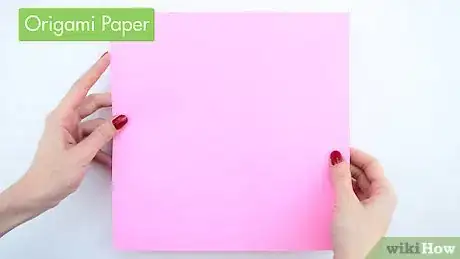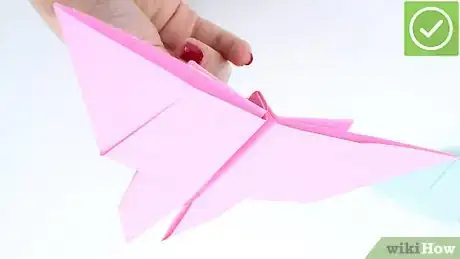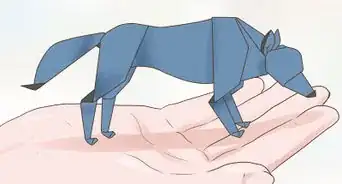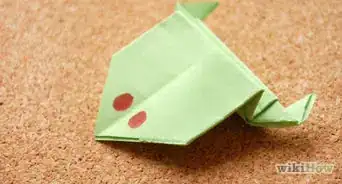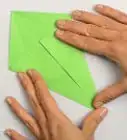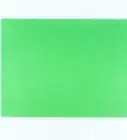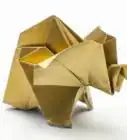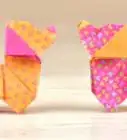wikiHow is a “wiki,” similar to Wikipedia, which means that many of our articles are co-written by multiple authors. To create this article, 42 people, some anonymous, worked to edit and improve it over time.
This article has been viewed 607,783 times.
Learn more...
Origami, the Japanese art of paper-folding, dates back centuries. Origami creations range from simple and delightful to complex and astounding. Origami butterflies are an easy beginner project, making them a perfect children's activity. All you need is a piece of square paper, and with a few folds, you'll have an ethereal paper creature! Give your butterfly as a present, attach one to gift wrapping, or simply use it to brighten up a room.
Steps
Making the Origami Boat Base
-
1Start with a square piece of paper. If you are using origami paper, there is one side that is shiny and/or decorated – this is the right side. Lay the paper right-side down.
- A 6 x 6 inch (15 x 15 cm) square is a good size for beginners. If you want to create larger or smaller butterflies, adjust your paper size accordingly.
-
2Make a horizontal valley crease. Match the paper's lower edge to the upper edge and smooth the crease with your fingers, starting from the center and working your way out. Unfold the paper so the crease remains.
- In the valley fold, you fold the paper over the crease, so that the sides of the paper that were facing up are now folded in on each other. The resulting crease is "under" the folded sides, hence the name "valley."
Advertisement -
3Make a vertical valley crease through the center. Match the right edge to the left edge and crease with your fingers, then unfold.
- Steps 2 and 3 are combined in this video.
- Now you should have two valley creases: one running horizontally and one vertically through the center.
-
4Rotate the paper 45 degrees. Turn the paper counterclockwise so that what was the lower left corner now points downwards towards you.
-
5Make a horizontal valley fold. Carefully bring the lower corner to the upper corner, crease, and unfold.
-
6Make a vertical valley fold. Bring the right corner over to the left corner, crease, and unfold.
- Steps 5 and 6 are shown in the video.
-
7Rotate the paper 45 degrees. Turn the paper clockwise or counterclockwise so that an edge (rather than a corner) is facing you.
- There should be four valley creases though the center: a vertical, a horizontal, and two diagonal.
-
8Fold the left and right sides to meet the central vertical crease. Align the right edge of the paper with the middle vertical crease and make a fold. Repeat with the left side.
- Do not unfold these creases.
- This is called a "gate fold."
-
9Lift and slightly open the diagonal creases in the top left and right corners. Insert your thumb and middle finger under the folded corners, holding the bottom half of the paper securely in place with your other hand.
-
10Fold the top edge down into a "roof" shape. Align the upper edge with the horizontal crease in the middle of the model. At the same time, open the flaps that you pinched in the previous step, pulling them apart and down until the top of the model meets the center crease.
- Now the upper half of the model should look like a roof on a house.
-
11Rotate the model 180 degrees. Now the "roof" is upside-down, facing you.
-
12Repeat steps 7 and 8 on the upper half. When you finish, you'll have what's called an origami "boat base," a starting point for many different creations.[1]
Making the Wings
-
1Flip the model over. The folded edges you made in the last step should now be face-down. The corners of the "boat" should be pointing to the sides, with the two long edges extending horizontally along the top and bottom of the model.
-
2Fold the upper half down. Join the upper edge to the lower edge and smooth the valley fold with your fingers.
-
3Valley-fold the top right flap down. Holding the trapezoid-shaped model so the long edge is at the top (as at the end of Step 2), lift the top right corner and bring it downwards toward the model's vertical axis. Crease the fold with your fingers.
- The flap's corner should now be pointing downwards towards you.
- Note that the right corner has multiple layers: you are folding down only the top one.
-
4Repeat Step 3 for the left flap. When you finish, both corners will be pointing down towards you.
-
5Make a small valley fold in the left flap. Examine the left flap you've just folded down, noticing the mountain fold (upward-facing fold) running diagonally from the central vertical axis and ending in a side corner. Lift the side corner slightly, moving it inwards and upwards toward the center (but not all the way). Smooth the fold with your fingers.
- The fold should extend all the way from the upper edge of the model to about halfway between the corner you're lifting and the flap's lower point.
-
6Repeat Step 6 for the right flap. Because there are no guiding creases for these folds, take care to make the left and right folds even.
- The video shows Steps 6 and 7.
-
7Turn the model over. The folds you've just made should now be face-down to the working surface, with the flaps still pointing downwards towards you.
-
8Valley-fold the model in half vertically. Bring the left corner over to the right and reinforce the crease with your fingers.
Shaping the Body
-
1Make a diagonal valley fold in the upper wing. Lift the upper "wing" (which is currently extending straight out to the right) and bring it backwards (to the left), creating a fold that starts about 1/2 inch (1 cm) from the left corner of the upper edge and extends diagonally to the lower left corner of the upper flap. Crease with your fingers and then unfold.
-
2Flip the model over. Now the wing tips should be pointing left, and the crease you've just made is face-down on the working surface.
-
3Repeat Step 1 for the other upper wing. This time, bring it up and back towards the right. Create a fold that starts 1/2 inch (1 cm) from the right corner of the upper edge and extends down and right to the lower right corner of the upper flap. Crease and unfold.
-
4Open the wings. Orient the model so that the central vertical fold is "mountain," or upwards-facing.[2]
-
5Pinch along the folds you made in Steps 1-3. This is the body of the butterfly.
- Push the wings back along the creases to reinforce the folds.
-
6Give your butterfly as a gift, or use as a decoration. Try making more in different colors and sizes.
Community Q&A
-
QuestionHow small or big does the paper have to be?
 Community AnswerYou can use any size paper. It depends on how big or small you want the butterfly.
Community AnswerYou can use any size paper. It depends on how big or small you want the butterfly. -
QuestionIs it easy to make a paper butterfly?
 Community AnswerThis paper butterfly is suitable for intermediate origami skill levels.
Community AnswerThis paper butterfly is suitable for intermediate origami skill levels. -
QuestionCan I use cardboard?
 R8118Community AnswerNo. Cardboard is too thick to fold. Use something like origami paper, a post-it, or cut a square out of A4 paper. Make sure it is thin and easy to work with.
R8118Community AnswerNo. Cardboard is too thick to fold. Use something like origami paper, a post-it, or cut a square out of A4 paper. Make sure it is thin and easy to work with.
Things You'll Need
- Origami paper
References
About This Article
To make butterfly origami, you’ll need a square piece of paper. To start, fold and crease it in half horizontally, vertically, and diagonally, unfolding after each fold. Fold the top and bottom sides to meet at the center crease. Then, rotate the paper clockwise and fold the top and bottom sides to the center to make a square. Unfold the top flap and fold the top edge down into a roof shape. Repeat this for the bottom flap. After creasing and folding your paper into a boat base, flip the model over and fold it up in half. Lift the right corner and fold it up and then repeat on the left side. Now, rotate the triangle shape you've just created 180°. Lift the right and left inner flaps and fold them towards half-way the center. Then, fold the model in half. Fold the upper wings down diagonally to create its body on both sides, and your butterfly is done!
